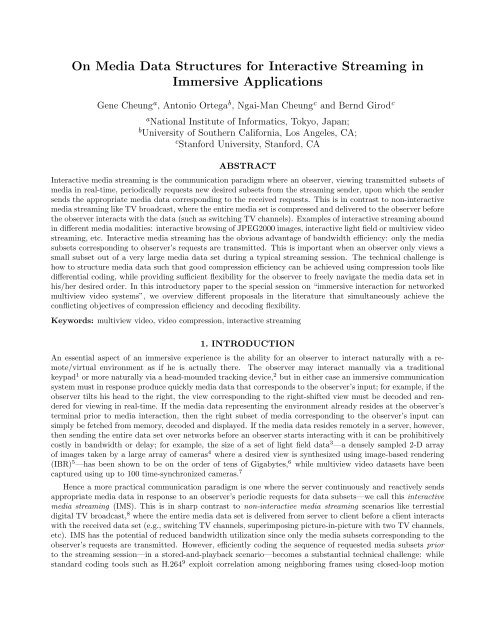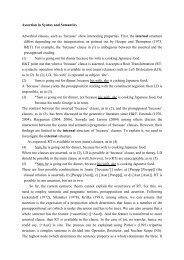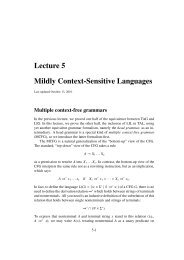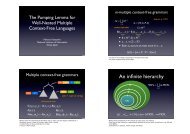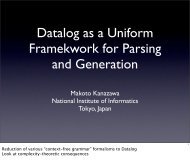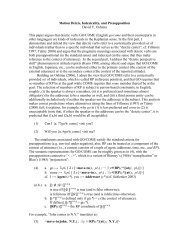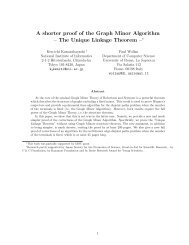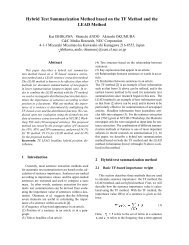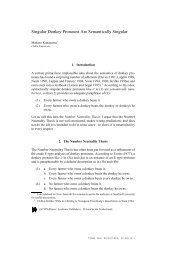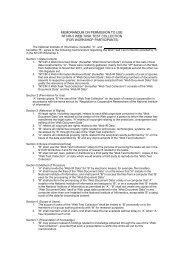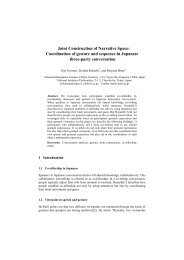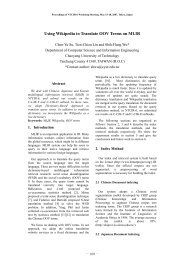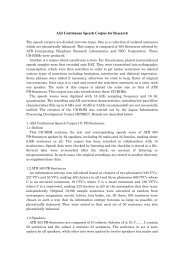On Media Data Structures for Interactive Streaming in Immersive ...
On Media Data Structures for Interactive Streaming in Immersive ...
On Media Data Structures for Interactive Streaming in Immersive ...
You also want an ePaper? Increase the reach of your titles
YUMPU automatically turns print PDFs into web optimized ePapers that Google loves.
<strong>On</strong> <strong>Media</strong> <strong>Data</strong> <strong>Structures</strong> <strong>for</strong> <strong>Interactive</strong> <strong>Stream<strong>in</strong>g</strong> <strong>in</strong><strong>Immersive</strong> ApplicationsGene Cheung a , Antonio Ortega b , Ngai-Man Cheung c and Bernd Girod ca National Institute of In<strong>for</strong>matics, Tokyo, Japan;b University of Southern Cali<strong>for</strong>nia, Los Angeles, CA;c Stan<strong>for</strong>d University, Stan<strong>for</strong>d, CAABSTRACT<strong>Interactive</strong> media stream<strong>in</strong>g is the communication paradigm where an observer, view<strong>in</strong>g transmitted subsets ofmedia <strong>in</strong> real-time, periodically requests new desired subsets from the stream<strong>in</strong>g sender, upon which the sendersends the appropriate media data correspond<strong>in</strong>g to the received requests. This is <strong>in</strong> contrast to non-<strong>in</strong>teractivemedia stream<strong>in</strong>g like TV broadcast, where the entire media set is compressed and delivered to the observer be<strong>for</strong>ethe observer <strong>in</strong>teracts with the data (such as switch<strong>in</strong>g TV channels). Examples of <strong>in</strong>teractive stream<strong>in</strong>g abound<strong>in</strong> different media modalities: <strong>in</strong>teractive brows<strong>in</strong>g of JPEG2000 images, <strong>in</strong>teractive light field or multiview videostream<strong>in</strong>g, etc. <strong>Interactive</strong> media stream<strong>in</strong>g has the obvious advantage of bandwidth efficiency: only the mediasubsets correspond<strong>in</strong>g to observer’s requests are transmitted. This is important when an observer only views asmall subset out of a very large media data set dur<strong>in</strong>g a typical stream<strong>in</strong>g session. The technical challenge ishow to structure media data such that good compression efficiency can be achieved us<strong>in</strong>g compression tools likedifferential cod<strong>in</strong>g, while provid<strong>in</strong>g sufficient flexibility <strong>for</strong> the observer to freely navigate the media data set <strong>in</strong>his/her desired order. In this <strong>in</strong>troductory paper to the special session on “immersive <strong>in</strong>teraction <strong>for</strong> networkedmultiview video systems”, we overview different proposals <strong>in</strong> the literature that simultaneously achieve theconflict<strong>in</strong>g objectives of compression efficiency and decod<strong>in</strong>g flexibility.Keywords: multiview video, video compression, <strong>in</strong>teractive stream<strong>in</strong>g1. INTRODUCTIONAn essential aspect of an immersive experience is the ability <strong>for</strong> an observer to <strong>in</strong>teract naturally with a remote/virtualenvironment as if he is actually there. The observer may <strong>in</strong>teract manually via a traditionalkeypad 1 or more naturally via a head-mounded track<strong>in</strong>g device, 2 but <strong>in</strong> either case an immersive communicationsystem must <strong>in</strong> response produce quickly media data that corresponds to the observer’s <strong>in</strong>put; <strong>for</strong> example, if theobserver tilts his head to the right, the view correspond<strong>in</strong>g to the right-shifted view must be decoded and rendered<strong>for</strong> view<strong>in</strong>g <strong>in</strong> real-time. If the media data represent<strong>in</strong>g the environment already resides at the observer’sterm<strong>in</strong>al prior to media <strong>in</strong>teraction, then the right subset of media correspond<strong>in</strong>g to the observer’s <strong>in</strong>put cansimply be fetched from memory, decoded and displayed. If the media data resides remotely <strong>in</strong> a server, however,then send<strong>in</strong>g the entire data set over networks be<strong>for</strong>e an observer starts <strong>in</strong>teract<strong>in</strong>g with it can be prohibitivelycostly <strong>in</strong> bandwidth or delay; <strong>for</strong> example, the size of a set of light field data 3 —a densely sampled 2-D arrayof images taken by a large array of cameras 4 where a desired view is synthesized us<strong>in</strong>g image-based render<strong>in</strong>g(IBR) 5 —has been shown to be on the order of tens of Gigabytes, 6 while multiview video datasets have beencaptured us<strong>in</strong>g up to 100 time-synchronized cameras. 7Hence a more practical communication paradigm is one where the server cont<strong>in</strong>uously and reactively sendsappropriate media data <strong>in</strong> response to an observer’s periodic requests <strong>for</strong> data subsets—we call this <strong>in</strong>teractivemedia stream<strong>in</strong>g (IMS). This is <strong>in</strong> sharp contrast to non-<strong>in</strong>teractive media stream<strong>in</strong>g scenarios like terrestialdigital TV broadcast, 8 where the entire media data set is delivered from server to client be<strong>for</strong>e a client <strong>in</strong>teractswith the received data set (e.g., switch<strong>in</strong>g TV channels, superimpos<strong>in</strong>g picture-<strong>in</strong>-picture with two TV channels,etc). IMS has the potential of reduced bandwidth utilization s<strong>in</strong>ce only the media subsets correspond<strong>in</strong>g to theobserver’s requests are transmitted. However, efficiently cod<strong>in</strong>g the sequence of requested media subsets priorto the stream<strong>in</strong>g session—<strong>in</strong> a stored-and-playback scenario—becomes a substantial technical challenge: whilestandard cod<strong>in</strong>g tools such as H.264 9 exploit correlation among neighbor<strong>in</strong>g frames us<strong>in</strong>g closed-loop motion
Table 1. Proposed <strong>Media</strong> <strong>Structures</strong> For IMSApplication Structur<strong>in</strong>g TechniqueROI image brows<strong>in</strong>g JPEG2000 10video brows<strong>in</strong>g JPEG2000+CR, 11 JPEG2000+MC 12light field stream<strong>in</strong>g rerout<strong>in</strong>g, 13,14 SP 15<strong>in</strong>tra DSC, 16 DSC+MC+coset 17ROI video stream<strong>in</strong>g multi-res MC 18,19reversible video playback DSC+MC 20multiview stream<strong>in</strong>g DSC+MC 21rerout<strong>in</strong>g, 22 redundant P-frames 22,23compensation <strong>for</strong> cod<strong>in</strong>g ga<strong>in</strong>, the obvious correlation that exists among requested media subsets is difficult toexploit s<strong>in</strong>ce at cod<strong>in</strong>g time, the order and selection of media subsets chosen by the observer dur<strong>in</strong>g stream<strong>in</strong>gtime <strong>in</strong> the future is unknown. This is the <strong>in</strong>herent tension between media <strong>in</strong>teractivity and cod<strong>in</strong>g efficiency;i.e., provid<strong>in</strong>g maximum “navigation” flexibility can come at the cost of lower cod<strong>in</strong>g efficiency.Over the past few years, as shown <strong>in</strong> Table 1, researchers have devised novel cod<strong>in</strong>g structures and techniquesto achieve different tradeoffs between media <strong>in</strong>teractivity and cod<strong>in</strong>g efficiency. In this <strong>in</strong>troductory paper <strong>for</strong>the special session on “immersive <strong>in</strong>teraction <strong>for</strong> networked multiview video systems”, we provide a detailedoverview of various proposals <strong>in</strong> the literature. A key contribution of this work is to provide, <strong>for</strong> the first time,taxonomies of these methods and how they relate to each other. The outl<strong>in</strong>e of the paper is as follows. Wefirst overview different proposed encoded data structures <strong>for</strong> different media modalities <strong>in</strong> Section 2. We thenpresent two taxonomies on how different proposals are related <strong>in</strong> Section 3. We then narrow our focus to as<strong>in</strong>gle application—<strong>in</strong>teractive multiview video stream<strong>in</strong>g—and how how quantitatively different quantities canbe traded off <strong>in</strong> Section 4. F<strong>in</strong>ally, conclud<strong>in</strong>g remarks are presented <strong>in</strong> Section 5.2. OVERVIEW OF STRUCTURES & TECHNIQUES FOR IMSWe first overview various proposed structures and techniques <strong>in</strong> the literature <strong>for</strong> IMS. IMS has been used <strong>for</strong>a wide range of media modalities and applications; see Table 1 <strong>for</strong> a list of applications and correspond<strong>in</strong>gtechniques to support the applications.2.1 ROI Image Brows<strong>in</strong>gFor Region-Of-Interest (ROI) image brows<strong>in</strong>g, where an observer can <strong>in</strong>teractively select a region of any locationand scale <strong>in</strong> a possibly very large image (e.g., a geographical map), Taubman et al 10 has proposed the use ofJPEG2000 image cod<strong>in</strong>g standard <strong>for</strong> its f<strong>in</strong>e-gra<strong>in</strong>ed spatial, resolution and quality scalability. 24 In details,given the set of subband coefficients of a discrete wavelet trans<strong>for</strong>m already resid<strong>in</strong>g at the observer’s cache,the sender sends only the miss<strong>in</strong>g coefficients correspond<strong>in</strong>g to the requested spatial location and scale of therequested ROI, <strong>in</strong> <strong>in</strong>crementally rate-distortion optimal quality layers called packets 10 to the observer. The imagecan be displayed cont<strong>in</strong>uously at the observer as more packets are received with gradually improv<strong>in</strong>g quality.2.2 Video Brows<strong>in</strong>gExploit<strong>in</strong>g scalable nature of JPEG2000, proposals 11,12 have also been made to use JPEG2000 <strong>for</strong> video brows<strong>in</strong>g,where the stream<strong>in</strong>g video can be randomly accessed with complete flexibility at the frame level: randomaccess any frame <strong>in</strong> sequence, <strong>for</strong>ward/backward playback <strong>in</strong> time, playback at K× speed by decod<strong>in</strong>g only everyK frames, etc. Though at encod<strong>in</strong>g time each frame is encod<strong>in</strong>g <strong>in</strong>dependently, <strong>in</strong>ter-frame redundancy cannevertheless be exploited. Devaux et al 11 proposed to use conditional replenishment (CR), where the coefficientsof a code-block of a desired frame were sent or replenished only if the correspond<strong>in</strong>g code-block of the previousframe already at the decoder did not provide a good enough approximation. Along similar l<strong>in</strong>e, assum<strong>in</strong>g amotion model Taubman et al 12 per<strong>for</strong>med motion compensation (MC) at the server, so that the transmittedmotion <strong>in</strong><strong>for</strong>mation could be used <strong>in</strong> comb<strong>in</strong>ation of code-blocks of previous frames to approximately reconstructcode-blocks of requested frames. The server would send new code-blocks only if the motion-compensatedapproximation was not good enough.
2.3 Reversible Video PlaybackAnother example is reversible video playback: 20 a video frame was encoded us<strong>in</strong>g distributed source cod<strong>in</strong>g(DSC), where both past and future frames were used as side <strong>in</strong><strong>for</strong>mation (predictors). This was done so thatframes could be sent either <strong>for</strong>ward or backward <strong>in</strong> time per client’s request, and the client could simply decodeand play back the video <strong>in</strong> the transmission order with no excess buffer<strong>in</strong>g. Note that this was a more limited<strong>for</strong>m of media <strong>in</strong>teractivity than video brows<strong>in</strong>g, but unlike JPEG2000-based approaches 11,12 <strong>for</strong> video brows<strong>in</strong>g,where each frame was encoded <strong>in</strong>dependently, the <strong>in</strong>ter-frame redundancy was explicitly exploited here dur<strong>in</strong>gactual media encod<strong>in</strong>g, hence the result<strong>in</strong>g encod<strong>in</strong>g rate is expected to be much lower.2.4 <strong>Interactive</strong> Light Field <strong>Stream<strong>in</strong>g</strong>In the case of light fields, 3 where a subset of a densely sampled 2-D array of images is used to <strong>in</strong>terpolate adesired view us<strong>in</strong>g image-based render<strong>in</strong>g (IBR), 5 the notion of <strong>in</strong>teractive media stream<strong>in</strong>g has been <strong>in</strong>vestigatedextensively. 13–17 These works were motivated by the very large size of the orig<strong>in</strong>al image set, 6 which will cause<strong>in</strong>tolerable delay if the set must be transmitted <strong>in</strong> its entirety be<strong>for</strong>e user’s <strong>in</strong>teraction beg<strong>in</strong>s.To provide random access to images <strong>in</strong> the set, Aaron et al 16 coded images <strong>in</strong>dependently. Aaron et al 16(<strong>in</strong>tra DSC) encoded non-key images (key images are encoded as I-frames) <strong>in</strong>dependently us<strong>in</strong>g a Wyner-Zivencoder, and transmitted different amount of the encoded bits depend<strong>in</strong>g on the quality of the side <strong>in</strong><strong>for</strong>mation(frames already transmitted) available at the decoder. To exploit the large spatial correlation <strong>in</strong>herent amongdensely sampled images, however, the majority of these works 13–15,17 encoded the image set us<strong>in</strong>g disparitycompensation, i.e., differential cod<strong>in</strong>g us<strong>in</strong>g neighbor<strong>in</strong>g view images as predictors.For a given image, Jagmohan et al 17 and Ramanathan et al 15 used DSC and SP-frame-like lossless cod<strong>in</strong>grespectively to elim<strong>in</strong>ate frame differences caused by usage of different predictors of different decod<strong>in</strong>g paths.Specifically, Jagmohan et al 17 proposed to encode disparity <strong>in</strong><strong>for</strong>mation <strong>for</strong> every possible neighbor<strong>in</strong>g viewimage, plus DSC based coset bits so that when both are applied, the result<strong>in</strong>g image is the same no matterwhich neighbor<strong>in</strong>g image was used as predictor. Instead of DSC, Ramanathan et al 15 used a lossless cod<strong>in</strong>gscheme ak<strong>in</strong> to SP-frames <strong>in</strong> H.264 25 to encode residues after disparity compensation so that the exact sameframe was reconstructed no matter which predictor was used.Bauermann et al 13,14 took a different approach and analyzed tradeoffs among four quantities—storage rate,distortion, transmission data rate and decod<strong>in</strong>g complexity. In particular, they first assumed that each cod<strong>in</strong>gblock of an image was encoded as INTRA, INTER or SKIP as done <strong>in</strong> H.263. 26 Then, <strong>for</strong> a requested INTERcod<strong>in</strong>g block to be correctly decoded, all blocks <strong>in</strong> its dependency cha<strong>in</strong> ∗ that were not already <strong>in</strong> the clientcache must be transmitted, creat<strong>in</strong>g a cost both <strong>in</strong> transmission rate and decod<strong>in</strong>g complexity. We denote thistechnique as rerout<strong>in</strong>g, as the dependency path of blocks from desired <strong>in</strong>ter block all the way back to the <strong>in</strong>itial<strong>in</strong>tra block must be re-traced and transmitted if not resid<strong>in</strong>g <strong>in</strong> the observer’s cache.2.5 ROI Video <strong>Stream<strong>in</strong>g</strong>A recent application called ROI video stream<strong>in</strong>g <strong>in</strong>volves the transmission of high-resolution video to an observerwith low-resolution display term<strong>in</strong>al. In such scenario, the observer can choose between view<strong>in</strong>g the entire spatialregion but <strong>in</strong> low resolution, or view<strong>in</strong>g a selected smaller ROI but <strong>in</strong> higher resolution. Mavlankar et al 18,19proposed a multi-resolution motion compensation (multi-res MC) technique where a low resolution version of thevideo called thumbnail was first encoded, then frames at higher resolution were each divided <strong>in</strong>to different tiledspatial regions, which were motion-compensated us<strong>in</strong>g an up-sampled version of the thumbnail as predictor.Prediction <strong>for</strong> the high-resolution frames used only the thumbnail, so that ROIs could be arbitrarily chosenacross time by observers without caus<strong>in</strong>g complicated <strong>in</strong>ter-frame dependencies among high-resolution frames.The procedure can be repeated <strong>for</strong> even smaller spatial regions and higher resolution.∗ By dependency cha<strong>in</strong> we mean all the blocks that need to be decoded be<strong>for</strong>e the requested block can be decoded, i.e.,an INTRA block followed by a succession of disparity compensated INTER blocks.
2.6 <strong>Interactive</strong> Multiview Video <strong>Stream<strong>in</strong>g</strong>While much of multiview video cod<strong>in</strong>g 27–29 focuses on the rate-distortion per<strong>for</strong>mance of compress<strong>in</strong>g all framesof all views <strong>for</strong> storage or non-<strong>in</strong>teractive video delivery over networks, <strong>in</strong> our previous works 21–23 we haveaddressed the problem of design<strong>in</strong>g a frame structure to enable <strong>in</strong>teractive multiview video stream<strong>in</strong>g, whereclients can <strong>in</strong>teractively switch views dur<strong>in</strong>g video playback <strong>in</strong> time. Thus, as a client is play<strong>in</strong>g back successiveframes (<strong>in</strong> time) <strong>for</strong> a given view, it can send a request to the server to switch to a different view while cont<strong>in</strong>u<strong>in</strong>gun<strong>in</strong>terrupted temporal playback. To provide view switch<strong>in</strong>g capability <strong>for</strong> the observer while ma<strong>in</strong>ta<strong>in</strong><strong>in</strong>g goodcompression efficiency, we have developed redundant P-frame representation 22 where multiple P-frames areencoded <strong>for</strong> the same orig<strong>in</strong>al picture and stored at the encoder, each us<strong>in</strong>g as a predictor a different previousframe that was on a possible observer’s navigation trajectory. Multiple representation nature of redundant P-frames means they lower transmission rate at the expense of more storage of media data. But an <strong>in</strong>-discrim<strong>in</strong>atoryuse of redundant P-frame representation will lead to exponential expenditure <strong>in</strong> storage; to avoid such problemelegantly without resort<strong>in</strong>g to bandwidth-expensive I-frame, we developed novel DSC implementations 21 to mergeswitches from multiple decod<strong>in</strong>g paths <strong>in</strong>to a s<strong>in</strong>gle frame representation. Our most recent work 23 discussedprelim<strong>in</strong>ary results of us<strong>in</strong>g I-, P- and DSC frames <strong>in</strong> an optimized structure <strong>for</strong> <strong>in</strong>teractive multiview videostream<strong>in</strong>g.3. TAXONOMY OF STRUCTURES & TECHNIQUES FOR IMSNOINTRASender tracksdecoder’s state?YESJPEG2000rerout<strong>in</strong>gmulti−res MCYESDecoder decodes eachframe uniquely?YESSP<strong>in</strong>tra DSCDSC+MC+cosetDSC+MCNOUpon decod<strong>in</strong>g,decoder has uniquedecoded version?NOJPEG2000 + CRJPEG2000 + MCredundant P−framesunique decod<strong>in</strong>gmultiple decod<strong>in</strong>gunique encod<strong>in</strong>g rerout<strong>in</strong>g 13,14,22 JPEG2000+CR 11JPEG2000 10 JPEG2000+MC 12<strong>in</strong>tra DSC 16multi-res MC 18,19multiple encod<strong>in</strong>g SP 15 redundant P-frames 22DSC+MC+coset 17DSC+MC 21(a) Complexity-Driven Taxonomy(b) <strong>Data</strong>-Driven TaxonomyFigure 1. Two Taxonomies categoriz<strong>in</strong>g <strong>Structures</strong> & Techniques <strong>for</strong> IMSAfter review<strong>in</strong>g proposed techniques <strong>for</strong> different IMS applications <strong>in</strong> the literature, <strong>in</strong> this section we discusstwo taxonomies to classify previously proposed media structur<strong>in</strong>g techniques that achieve different tradeoffsbetween <strong>in</strong>teractivity and compression efficiency <strong>in</strong>to logical categories. See Fig. 1 <strong>for</strong> an illustration.3.1 Complexity-driven TaxonomyThe first taxonomy is complexity-driven and can be described as follows. First, media data can be structured suchthat when the sender receives a request from the observer correspond<strong>in</strong>g to a specific media subset, the senderdoes not need to know <strong>in</strong> what state the decoder is <strong>in</strong> (i.e., what media data has already been transmitted anddecoded at the observer). This is the INTRA structure: an encod<strong>in</strong>g scheme codes each frame <strong>in</strong>dependently,and dur<strong>in</strong>g the stream<strong>in</strong>g session the sender simply sends the media subset that directly corresponds to theobserver’s request. This requires the least computation of all structure techniques. Though simplistic, whenthere is little correlation to exploit <strong>for</strong> cod<strong>in</strong>g ga<strong>in</strong> between requested media subsets, this is a perfectly viableapproach.Alternatively, the sender can keep track of the decoder’s state (what media data has been transmitted) andsends different subsets of media data accord<strong>in</strong>g to both the observer’s request and the decoder’s state. Thesimple sub-category here is the class of techniques where the media is encoded such that there is only one
unique way of decod<strong>in</strong>g the requested media data subset. In this case, the sender simply sends the subset ofthe requested media that are miss<strong>in</strong>g from the receiver’s cache, so that the decoder can per<strong>for</strong>m the requiredunique decod<strong>in</strong>g. JPEG2000-based scheme 10 <strong>for</strong> ROI image brows<strong>in</strong>g, rerout<strong>in</strong>g 13,14 <strong>for</strong> light field stream<strong>in</strong>g,and multi-res MC 18,19 <strong>for</strong> ROI video stream<strong>in</strong>g are examples of this category.In the next class of structures, each structure has more than one unique way of decod<strong>in</strong>g each requestedmedia subset, but there is only one unique decoded version. DSC <strong>for</strong> reversible video playback, 20 SP-frames<strong>for</strong> light field stream<strong>in</strong>g, 15 DSC-based techniques <strong>for</strong> light field stream<strong>in</strong>g 16,17 and DSC-based techniques <strong>for</strong><strong>in</strong>teractive multiview video stream<strong>in</strong>g 21 fall <strong>in</strong> this class. This requires more computation than the previous class,s<strong>in</strong>ce multiple ways to compute a given requested media subset means, first, an <strong>in</strong>crease <strong>in</strong> pre-computation toderive the multiple encod<strong>in</strong>gs, and second, a more complex mapp<strong>in</strong>g between decoder states and stored mediarepresentations.F<strong>in</strong>ally, the last class of structures result <strong>in</strong> multiple decoded versions <strong>for</strong> a given observer request. This isthe most complex class <strong>in</strong> that the multiple decoded versions lead to multiplicative <strong>in</strong>crease <strong>in</strong> the number ofdecoder states, which the server must keep track of. JPEG2000+CR 11 and JPEG2000+MC 12 <strong>for</strong> video brows<strong>in</strong>g,and Redundant P-frames 22,23 belong to this class. Typically, some methods to reduce the number of possibledecoder states such as novel DSC implementations 21 must be used be<strong>for</strong>e the exponential growth of decoderstates becomes <strong>in</strong>tractable.3.2 <strong>Data</strong>-driven TaxonomyAnother way of categoriz<strong>in</strong>g the proposed structur<strong>in</strong>g techniques <strong>in</strong> the literature is from a data-driven perspective.First, at the encoder a particular media subset can be encoded <strong>in</strong> one unique version, or multiple versions,us<strong>in</strong>g different neighbor<strong>in</strong>g frames as predictors, <strong>for</strong> example. At the decoder, at the end of the decod<strong>in</strong>g process,<strong>for</strong> a given request one can produce one or multiple decoded versions. Fig. 1(b) shows how the proposedtechniques fall <strong>in</strong>to different categories.While unique encod<strong>in</strong>g / unique decod<strong>in</strong>g and multiple encod<strong>in</strong>g / multiple decod<strong>in</strong>g are conceptually straight<strong>for</strong>ward,unique encod<strong>in</strong>g / multiple decod<strong>in</strong>g and multiple encod<strong>in</strong>g / unique decod<strong>in</strong>g are more subtle. Forunique encod<strong>in</strong>g / multiple decod<strong>in</strong>g, JPEG2000+CR 11 and JPEG2000+MC 12 both encode images <strong>in</strong>dependentlyand uniquely us<strong>in</strong>g JPEG2000 dur<strong>in</strong>g encod<strong>in</strong>g, then dur<strong>in</strong>g actually stream<strong>in</strong>g, generate motion <strong>in</strong><strong>for</strong>mation<strong>for</strong> given previous frame (predictor), so that different decoded versions are resulted <strong>for</strong> different previousframes at the decoder buffer. For multiple encod<strong>in</strong>g / unique decod<strong>in</strong>g, different motion <strong>in</strong><strong>for</strong>mation are preencoded<strong>for</strong> different previous frames. The nature of SP and DSC frames ensures that the same unique decodedversion can be recovered despite the difference <strong>in</strong> predictors.4. EXAMPLE IMS APPLICATION: INTERACTIVE MULTIVIEW VIDEOSTREAMINGFor a given IMS application, there are tradeoffs among several quantities that must be optimized <strong>in</strong> an applicationspecificmanner: transmission rate of the actual <strong>in</strong>teractive stream<strong>in</strong>g session, storage required <strong>for</strong> pre-encodedmedia data, encod<strong>in</strong>g and decod<strong>in</strong>g complexity, level of <strong>in</strong>teraction supported, etc. In this section, we focus on aspecific application—<strong>in</strong>teractive multiview video stream<strong>in</strong>g (IMVS) 21–23 —and study how these tradeoffs can beoptimized.4.1 Overview of IMVS and IMVS-specific Cod<strong>in</strong>g ToolsAs briefly described earlier, IMVS is an application where a multiview video sequence is first pre-encoded andstored at the server <strong>in</strong> a redundant representation, so that dur<strong>in</strong>g a subsequent stream<strong>in</strong>g session, an <strong>in</strong>teractiveclient can periodically request view switches at pre-def<strong>in</strong>ed period of M frames as video is be<strong>in</strong>g streamed andplayed back un<strong>in</strong>terrupted. Fig. 2(a) shows an overview of an IMVS system. Note that an alternative approach ofreal-time encod<strong>in</strong>g a decod<strong>in</strong>g path tailored <strong>for</strong> each client’s unique view traversal across time is computationallyprohibitive as the number of <strong>in</strong>teractive clients <strong>in</strong>crease.The challenge <strong>in</strong> IMVS is to design a frame structure <strong>for</strong> multiview video data so that stream<strong>in</strong>g bandwidth isoptimally traded off with storage required to store the multiview video data, to support a desired level of IMVS
MV VideoSourceK camerasMV encod<strong>in</strong>gvideo servermultiviewdataview demandsrequested MV videoview demandsrequested MV video(a) IMVS System Overview<strong>in</strong>teractiveclient...<strong>in</strong>teractiveclientFi−1,1Fi−1,2Fi−1,1Fi−1,2F i,2F i,2Fi−1,3Fi−1,3i) redundant P−frames ii) M−frame(b) Frame Types <strong>for</strong> IMVSFigure 2. IMVS System Overview and Example Frame Types<strong>in</strong>teraction. By IMVS <strong>in</strong>teraction, we mean both the view switch<strong>in</strong>g period M (small M leads to faster viewswitches and more <strong>in</strong>teractivity), and likelihood that a user is to switch view given M. We def<strong>in</strong>e α to be theprobability that a user would choose to switch to a neighbor<strong>in</strong>g view at a view switch<strong>in</strong>g po<strong>in</strong>t; large α means auser is more likely to switch views, lead<strong>in</strong>g to more <strong>in</strong>teractivity.As build<strong>in</strong>g blocks to build an IMVS frame structure, we have previously proposed to use comb<strong>in</strong>ationsof redundant P-frames 22 and DSC-based merge-frames (M-frames). 21 Examples of these tools are shown <strong>in</strong>Fig. 2(b). Redundant P-frames encode one P-frame <strong>for</strong> each frame just prior to a view switch, us<strong>in</strong>g the previousframe as a predictor <strong>for</strong> differential cod<strong>in</strong>g, result<strong>in</strong>g <strong>in</strong> multiple frame representations <strong>for</strong> a given orig<strong>in</strong>al picture.In Fig. 2(b)(i), we see that there are three P-frames F i,2 ’s represent<strong>in</strong>g the same orig<strong>in</strong>al picture F1,2 o of time<strong>in</strong>stant 1 and view 2, each us<strong>in</strong>g a different frame <strong>in</strong> previous time <strong>in</strong>stant—one of F i−1,1 , F i−1,2 and F i−1,3 —aspredictor. While redundant P-frames result <strong>in</strong> low transmission bandwidth, it is obvious that us<strong>in</strong>g it alonewould lead to exponential growth <strong>in</strong> storage as the number of view switches across time <strong>in</strong>crease.As an alternative cod<strong>in</strong>g tool, we have proposed an M-frame, where a s<strong>in</strong>gle version F i,j of the orig<strong>in</strong>alpicture Fi,j o can be decoded no matter from which frame a user is switch<strong>in</strong>g from. In Fig. 2(b)(ii), the sameF i,2 can be decoded no matter which one of F i−1,1 F i−1,2 and F i−1,3 a user is switch<strong>in</strong>g from. <strong>On</strong>e straight<strong>for</strong>wardimplementation of M-frame is actually an I-frame. We have previously shown, however, that DSC-basedcod<strong>in</strong>g tools exploit<strong>in</strong>g the correlations between previous frames F i−1,k ’s and target frame F i,j can result <strong>in</strong>implementations that outper<strong>for</strong>m I-frame <strong>in</strong> both storage and transmission rate. An M-frame, however, rema<strong>in</strong>sa fair amount larger than a correspond<strong>in</strong>g P-frame.It should be obvious that a frame structure composed of large portions of redundant P-frames relative toM-frames will result <strong>in</strong> low transmission rate but large storage, while a structure composed of small portions ofredundant P-frames relative to M-frames will result <strong>in</strong> higher transmission rate but smaller storage. We referreaders to Cheung et al 23 <strong>for</strong> details on how an optimal structure is found <strong>for</strong> a desire transmission-storagetradeoff us<strong>in</strong>g comb<strong>in</strong>ation of redundant P-frames and M-frames, <strong>for</strong> given desired IMVS <strong>in</strong>teraction. We focus<strong>in</strong>stead on observ<strong>in</strong>g how the noted tradeoffs were manifested quantitatively <strong>in</strong> the IMVS context.4.2 IMVS TradeoffsWe now show quantitatively tradeoffs among transmission rate, storage and <strong>in</strong>teractivity. In Fig. 3(a) and (b),we see the per<strong>for</strong>mance of our optimized structures as different tradeoff po<strong>in</strong>ts between transmission and storage,<strong>for</strong> two test sequences akko&kayo and ballroom. They are coded at 320 ×240 resolution at 30 and 25 frames persecond, respectively. Quantization parameters (QP) were selected so that visual quality <strong>in</strong> peak Signal-to-noiseratio (PSNR) was about 34dB. View switch<strong>in</strong>g period M was fixed at 3. For each sequence, two trials wereper<strong>for</strong>med where the view switch<strong>in</strong>g probability α was set at 0.1 and 0.2.For both sequences, we see that at low storage, the difference between the two curves correspond<strong>in</strong>g to thetwo view switch<strong>in</strong>g probabilities is quite small. This agrees with our <strong>in</strong>tuition; at low storage, large portions ofthe frame structures are M-frames, which by design <strong>in</strong>duce the same transmission rate no matter from whichdecod<strong>in</strong>g path it is switch<strong>in</strong>g from. At high stroage, however, we see the difference between the two curvesbecomes larger. As more redundant P-frames are used, P-frames can selectively be deployed <strong>for</strong> decod<strong>in</strong>g pathswith high probabilities, lead<strong>in</strong>g to large reduction <strong>in</strong> transmission cost per P-frame encoded.
transmission cost <strong>in</strong> kbps240220200180160avg. transmission cost vs. storage <strong>for</strong> akkoIPM (a1)IPM (a2)transmission cost <strong>in</strong> kbps400380360340320300280avg. transmission cost vs. storage <strong>for</strong> ballroomIPM (a1)IPM (a2)transmission cost <strong>in</strong> kbps1402 3 4 5 6 7 8 9storage <strong>in</strong> kbytes per picture2402202001801601402604 6 8 10 12 14 16storage <strong>in</strong> kbytes per picture(a) akko&kayo, M = 3 (b) ballroom, M = 3Figure 3. Tradeoff between Transmission and Storage <strong>for</strong> different View Switch<strong>in</strong>g Probabilitiesavg. transmission cost vs. storage <strong>for</strong> akkoIPM (s3)IPM (s5)1202 3 4 5 6 7 8storage <strong>in</strong> kbytes per picturetransmission cost <strong>in</strong> kbps400380360340320300280avg. transmission cost vs. storage <strong>for</strong> ballroomIPM (s3)IPM (s5)2602 4 6 8 10 12 14storage <strong>in</strong> kbytes per picture(a) akko&kayo, α = 0.1 (b) ballroom, α = 0.1Figure 4. Tradeoff between Transmission and Storage <strong>for</strong> different View Switch<strong>in</strong>g PeriodsIn Fig. 4(a) and (b), we see the transmission-storage tradeoff of the optimized IMVS structures <strong>for</strong> the sametwo test sequences when the view switch<strong>in</strong>g period M changed from 3 to 5. Aga<strong>in</strong>, we see similar trend <strong>for</strong>the two sequences: per<strong>for</strong>mance curve <strong>for</strong> larger view switch<strong>in</strong>g period resides <strong>in</strong> a lower convex hull. This is<strong>in</strong>tuitive as well; large view switch<strong>in</strong>g period M means M − 1 P-frames of the same view can be used betweenswitches, lead<strong>in</strong>g to lower transmission rate.5. CONCLUSIONIn this <strong>in</strong>troductory paper, we first argue <strong>for</strong> the advantage of <strong>in</strong>teractive media stream<strong>in</strong>g over non-<strong>in</strong>teractivemedia stream<strong>in</strong>g, then overview exist<strong>in</strong>g cod<strong>in</strong>g techniques <strong>for</strong> different modalities to support <strong>in</strong>teractive mediastream<strong>in</strong>g. Each technique offers its own unique tradeoffs among different quantities: computation, transmissionrate, storage, and <strong>in</strong>teractivity. <strong>On</strong>e of our key contributions is to present taxonomies to categorize exist<strong>in</strong>gtechniques <strong>in</strong> a logical fashion. We also narrow our focus to the <strong>in</strong>teractive multiview video stream<strong>in</strong>g application,and present quantitative results that illustrated the said tradeoffs.REFERENCES[1] Lou, J.-G., Cai, H., and Li, J., “A real-time <strong>in</strong>teractive multi-view video system,” <strong>in</strong> [ACM International Conferenceon Multimedia], (November 2005).[2] Kurutepe, E., Civanlar, M. R., and Tekalp, A. M., “Client-driven selective stream<strong>in</strong>g of multiview video <strong>for</strong> <strong>in</strong>teractive3DTV,” <strong>in</strong> [IEEE Transactions on Circuits and Systems <strong>for</strong> Video Technology], 17, no.11, 1558–1565 (November2007).[3] Levoy, M. and Hanrahan, P., “Light field render<strong>in</strong>g,” <strong>in</strong> [Proc. SIGGRAPH’96], 31–42 (August 1996).[4] Wilburn, B., Smulski, M., Lee, H., and Horowitz, M., “The light field video camera,” <strong>in</strong> [SPIE Electronic Imag<strong>in</strong>g:<strong>Media</strong> Processors’2002], 4674 (December 2002).
[5] Shum, H.-Y., Kang, S. B., and Chan, S.-C., “Survey of image-based representations and compression techniques,”<strong>in</strong> [IEEE Transactions on Circuits and Systems <strong>for</strong> Video Technology], 13, no.11, 1020–1037 (November 2003).[6] Levoy, M. and Pulli, K., “The digital michelangelo project: 3-D scann<strong>in</strong>g of large statues,” <strong>in</strong> [Proc. SIGGRAPH’00],131–144 (August 2000).[7] Fujii, T., Mori, K., Takeda, K., Mase, K., Tanimoto, M., and Suenaga, Y., “Multipo<strong>in</strong>t measur<strong>in</strong>g system <strong>for</strong> videoand sound—100 camera and microphone system,” <strong>in</strong> [IEEE International Conference on Multimedia and Expo], (July2006).[8] “Digital video broadcast<strong>in</strong>g.” http://www.dvb.org/.[9] Wiegand, T., Sullivan, G., Bjontegaard, G., and Luthra, A., “Overview of the H.264/AVC video cod<strong>in</strong>g standard,”<strong>in</strong> [IEEE Transactions on Circuits and Systems <strong>for</strong> Video Technology], 13, no.7, 560–576 (July 2003).[10] Taubman, D. and Rosenbaum, R., “Rate-distortion optimized <strong>in</strong>teractive brows<strong>in</strong>g of JPEG2000 images,” <strong>in</strong> [IEEEInternational Conference on Image Process<strong>in</strong>g], (September 2003).[11] Devaux, F.-O., Meessen, J., Parisot, C., Delaigle, J., Macq, B., and Vleeschouwer, C. D., “A flexible video transmissionsystem based on JPEG2000 conditional replenishment with multiple references,” <strong>in</strong> [IEEE InternationalConference on Acoustics, Speech, and Signal Process<strong>in</strong>g], (April 2007).[12] Naman, A. T. and Taubman, D., “A novel paradigm <strong>for</strong> optimized scalable video transmission based on JPEG2000with motion,” <strong>in</strong> [IEEE International Conference on Image Process<strong>in</strong>g], (September 2007).[13] Bauermann, I. and Ste<strong>in</strong>bach, E., “RDTC optimized compression of image-based scene representation (part I):Model<strong>in</strong>g and theoretical analysis,” <strong>in</strong> [IEEE Transactions on Image Process<strong>in</strong>g], 17, no.5, 709–723 (May 2008).[14] Bauermann, I. and Ste<strong>in</strong>bach, E., “RDTC optimized compression of image-based scene representation (part II):Practical cod<strong>in</strong>g,” <strong>in</strong> [IEEE Transactions on Image Process<strong>in</strong>g], 17, no.5, 724–736 (May 2008).[15] Ramanathan, P. and Girod, B., “Random access <strong>for</strong> compressed light fields us<strong>in</strong>g multiple representations,” <strong>in</strong> [IEEEInternational Workshop on Multimedia Signal Process<strong>in</strong>g], (September 2004).[16] Aaron, A., Ramanathan, P., and Girod, B., “Wyner-Ziv cod<strong>in</strong>g of light fields <strong>for</strong> random access,” <strong>in</strong> [IEEE InternationalWorkshop on Multimedia Signal Process<strong>in</strong>g], (September 2004).[17] Jagmohan, A., Sehgal, A., and Ahuja, N., “Compression of lightfield rendered images us<strong>in</strong>g coset codes,” <strong>in</strong> [Thirty-Seventh Asilomar Conference on Signals, Systems and Computers], 1, 830–834 (November 2003).[18] Mavlankar, A., Baccichet, P., Varodayan, D., and Girod, B., “Optimal slice size <strong>for</strong> stream<strong>in</strong>g regions of high resolutionvideo with virtual pan/tilt/zoom functionality,” <strong>in</strong> [Proc. European Signal Process<strong>in</strong>g Conference (EUSIPCO-07)], (Sept. 2007).[19] Mavlankar, A. and Girod, B., “Background extraction and long-term memory motion-compensated prediction <strong>for</strong>spatial-random-access enabled video cod<strong>in</strong>g,” <strong>in</strong> [Proc. International Picture Cod<strong>in</strong>g Symposium (PCS)], (May 2009).[20] Cheung, N.-M., Wang, H., and Ortega, A., “Video compression with flexible playback order based on distributedsource cod<strong>in</strong>g,” <strong>in</strong> [IS&T/SPIE Visual Communications and Image Process<strong>in</strong>g (VCIP’06)], (January 2006).[21] Cheung, N.-M., Ortega, A., and Cheung, G., “Distributed source cod<strong>in</strong>g techniques <strong>for</strong> <strong>in</strong>teractive multiview videostream<strong>in</strong>g,” <strong>in</strong> [27th Picture Cod<strong>in</strong>g Symposium], (May 2009).[22] Cheung, G., Ortega, A., and Cheung, N.-M., “Generation of redundant cod<strong>in</strong>g structure <strong>for</strong> <strong>in</strong>teractive multiviewstream<strong>in</strong>g,” <strong>in</strong> [Seventeenth International Packet Video Workshop], (May 2009).[23] Cheung, G., Cheung, N.-M., and Ortega, A., “Optimized frame structure us<strong>in</strong>g distributed source cod<strong>in</strong>g <strong>for</strong> <strong>in</strong>teractivemultiview stream<strong>in</strong>g,” <strong>in</strong> [IEEE International Conference on Image Process<strong>in</strong>g], (November 2009).[24] “JPEG2000 <strong>in</strong>teractive protocol (part 9—JPIP).” http://www.jpeg.org/jpeg2000/j2kpart9.html.[25] Karczewicz, M. and Kurceren, R., “The SP- and SI-frames design <strong>for</strong> H.264/AVC,” <strong>in</strong> [IEEE Transactions on Circuitsand Systems <strong>for</strong> Video Technology], 13, no.7, 637–644 (July 2003).[26] ITU-T Recommendation H.263, Video Cod<strong>in</strong>g <strong>for</strong> Low Bitrate Communication (February 1998).[27] Merkle, P., Smolic, A., Muller, K., and Wiegand, T., “Efficient prediction structures <strong>for</strong> multiview video cod<strong>in</strong>g,” <strong>in</strong>[IEEE Transactions on Circuits and Systems <strong>for</strong> Video Technology], 17, no.11, 1461–1473 (November 2007).[28] Flierl, M., Mavlankar, A., and Girod, B., “Motion and disparity compensated cod<strong>in</strong>g <strong>for</strong> multiview video,” <strong>in</strong> [IEEETransactions on Circuits and Systems <strong>for</strong> Video Technology], 17, no.11, 1474–1484 (November 2007).[29] Shimizu, S., Kitahara, M., Kimata, H., Kamikura, K., and Yashima, Y., “View scalable multiview cod<strong>in</strong>g us<strong>in</strong>g3-D warp<strong>in</strong>g with depth map,” <strong>in</strong> [IEEE Transactions on Circuits and Systems <strong>for</strong> Video Technology], 17, no.11,1485–1495 (November 2007).


